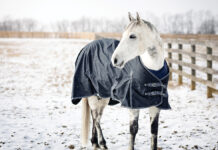Approximately 80 percent of the horses found after Hurricane Andrew, which hit Florida in 1992, did not have proper identification. Whatever the emergency—fire, tornado, hurricane or earthquake—here are a few safety tips to follow:
- Have your horse’s name, your name, telephone number and address on a luggage tag attached to a leather halter; have a second luggage tag ready, and braid it into your horse’s tail when a natural disaster is on the way; write any special instructions or medications on an index card, place it in a sealed baggie and tape it around your horse’s halter; purchase fetlock ID bands for both front feet; shave your phone number into your horse’s hair or write it on with a product that will not wash off in water.
- Make sure your horse is up-to-date on his vaccinations and Coggins test; keep this information and pictures of your horse from the front, back and sides (with a family member in the photo) along with any other information regarding permanent identification (such as scars, tattoos or microchip) in a plastic sealed baggie to take with you in case of an evacuation; also make sure your horse will load into a trailer quickly and easily.
- Have an evacuation plan in place for whatever type of emergency you may encounter; have two weeks of feed safely stored; if it’s safest to leave your horse, have the best area identified and leave plenty of water.
Emergency Contact Information
Horse Emergency Information






During Katrina, some folks used spray paint to put cell phone numbers, names etc on their horses. This held up REALLY well. Although we are in TX, we helped with the effort and took in a displaced horse to our ranch until it was placed back. VERY important. Also, microchipping is good, but the chips can migrate in the horse. Also, may facilities do not have the technology to find the chip, In an emergency…a “port-a-stall” is a very inexpensive alternative to finding boarding in a pinch. Small, in a box, and portable….no bigger than 1 foot by 4 feet square in a box..Fits anywhere! Also, have a water storage tank in your trailer (if you have one) which can be VERY beneficial….some horses will not drink strange water, and can colic from the stress. We have seen it all since Katrina. The advice on keeping coggins and photos is also very important. We are not fans on leaving on halters vs. spray paint on the butt, as halters can get caught if you must let your horse loose, and they may die, having never been found, or sadly, get strangled or hurt trying to “un-hook” themselves from a tree branch or other bad element while loose!!
this is good becuase you should never be left not knowing what to do in an emergency 🙂
great article. hope i never have to use any of the advise tho
Good article, though scary thought about using it!
As hurricane Katrina was bearing down on the gulf coast, the state of Mississippi turned back and refused entry to an incredible number of horses being evacuated. The owners of these horses had their cogins papers but not the health certificates. Some of these horses died in that storm , I know of four horses that were buried alive in mud (the owners chose to stay with their horses and barley survived), Thank you Mississippi. Please educate your readers before storm season there is one more piece of paper work possibly needed. If their vet has already evacuated they may be out of luck, are their animals lives worth gambling with.
Great article!
A lesson learned for humans from Katrina and Rita was to keep medical records on a CD and take it with you when you evacuate. This might be helpful for a horse with a complicated track record.
good info hope never have to use it
I microchipped my horse. It makes me sleep well at night!